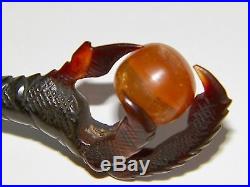
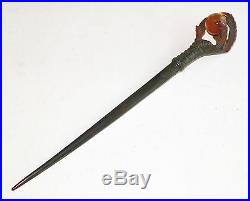
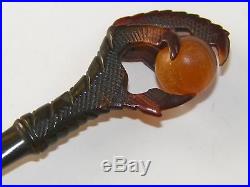

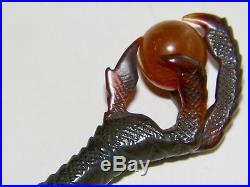
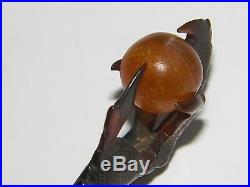

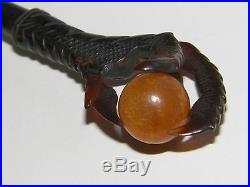


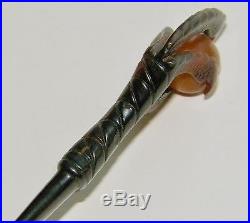


A Chinese Qing Dynasty, hand carved faux tortoiseshell dragon claw hair ornament. The three dimensional ornament is of four claws grasping an orb. The two toned orb moves freely, it is not fixed, the hair stick has flat sides. No chips, no insect damage, no visible wear. MEASURES: 7 in / 17.8 cm. Some information about dragons’ claws. The early Chinese dragons can be depicted with two to five claws. Different countries that adopted the Chinese dragon have different preferences; in Mongolia and Korea, the four-clawed dragons are used, while in Japanese dragon three-clawed dragons are common. By the Yuan dynasty, the five-clawed dragons became reserved for use by the emperor while the princes used four-clawed dragons. The Hongwu Emperor of the Ming dynasty emulated the Yuan dynasty rules on the use of the dragon motif and decreed that the dragon would be his emblem and that it would have five claws. The four-clawed dragon would become typically for imperial nobility and certain high-ranking officials. The three clawed dragon was used by lower ranks and the general public (widely seen on various Chinese goods in the Ming dynasty). The dragon, however, was only for select royalty closely associated with the imperial family, usually in various symbolic colors, while it was a capital offense for anyone other than the emperor himself to ever use the completely gold-colored, five-clawed Long dragon motif. Improper use of claw number or colors was considered treason, punishable by execution of the offender’s entire clan. The convention was carried into the Qing dynasty, and portraits of the Qing emperors were usually depicted with five-clawed dragons. KOREAN: Very occasionally a dragon may be depicted as carrying a dragon orb known as the Yeouiju in one or more of its claws or in its mouth. Modeled after the mythical Cintamani jewel or pearl, it was said that whoever could wield the Yeouiju was blessed with the abilities of omnipotence and creation at will, and that only four-toed dragons (who had thumbs with which to hold the orbs) were both wise and powerful enough to wield these orbs, as opposed to the lesser, three-toed dragons. Track Page Views With. Auctiva’s FREE Counter. The item “Antique Chinese Qing Dynasty Faux Tortoiseshell Hairpin Ornament Dragon Orb” is in sale since Friday, October 27, 2017. This item is in the category “Antiques\Asian Antiques\China\Other Chinese Antiques”. The seller is “myrnatoo” and is located in Minneapolis, Minnesota. This item can be shipped to United States.
- Color: Brown
- Age: 1850-1899
- Original/Reproduction: Original
- Type: Hair Ornament comb
- 19th C Chinese: Dragon Orb
- Ball & Claw Hair Ornament: Dragon Orb Hair Ornament
- Korean Dragon: 4 toed dragon
- Region of Origin: China
- Ball & Claw: 1800s Hair Ornament
